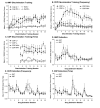Facilitation by drug states does not depend on acquired excitatory strength
- PMID: 17092575
- PMCID: PMC1800829
- DOI: 10.1016/j.bbr.2006.10.015
Facilitation by drug states does not depend on acquired excitatory strength
Abstract
Three experiments examined the effects of drug-extinction when a drug state served as a conditional stimulus (CS) for sucrose delivery or as a positive feature for pairings between a discrete CS (e.g., 15-s light-on) and sucrose. Some conditioning models predict that drug state will facilitate the conditional response (CR) based on an association with sucrose whether the drug is trained as a CS or as a facilitator. If so, repeated presentation of the drug state alone (drug-extinction) should decrease the CR in both situations. Nicotine (0.4mg/kg), amphetamine (AMP, 1mg/kg), and chlordiazepoxide (CDP, 5mg/kg) facilitated a goal tracking conditioned response to the discrete CS; however, AMP and CDP did not evoke reliable responding without an interposed stimulus, suggesting that associations between these drug states and sucrose are not expressed as anticipatory food seeking (goal tracking). Repeated presentation of each drug state alone did not disrupt facilitation by nicotine, amphetamine, or CDP; suggesting that the drug states did not facilitate goal tracking based on a direct association with sucrose. This latter finding implicates a higher-order or non-associative mechanism for facilitation of anticipatory food seeking by drug states in this Pavlovian discrimination task.
Figures





Similar articles
-
Occasion setting by drug states: Functional equivalence following similar training history.Behav Brain Res. 2008 Dec 22;195(2):260-70. doi: 10.1016/j.bbr.2008.09.009. Epub 2008 Sep 18. Behav Brain Res. 2008. PMID: 18845189 Free PMC article.
-
Stimulus properties of nicotine, amphetamine, and chlordiazepoxide as positive features in a pavlovian appetitive discrimination task in rats.Neuropsychopharmacology. 2005 Apr;30(4):731-41. doi: 10.1038/sj.npp.1300629. Neuropsychopharmacology. 2005. PMID: 15592350
-
Characterization of nicotine's ability to serve as a negative feature in a Pavlovian appetitive conditioning task in rats.Psychopharmacology (Berl). 2006 Mar;184(3-4):470-81. doi: 10.1007/s00213-005-0079-3. Epub 2005 Jul 27. Psychopharmacology (Berl). 2006. PMID: 16047193
-
Disentangling the nature of the nicotine stimulus.Behav Processes. 2012 May;90(1):28-33. doi: 10.1016/j.beproc.2011.10.020. Epub 2011 Nov 24. Behav Processes. 2012. PMID: 22119845 Free PMC article. Review.
-
A pharmacological analysis of processes underlying differential responding: a review and further experiments with scopolamine, amphetamine, lysergic acid diethylamide (LSD-25), chlordiazepoxide, physostigmine, and chlorpromazine.Behav Biol. 1976 Sep;18(1):1-74. doi: 10.1016/s0091-6773(76)91764-8. Behav Biol. 1976. PMID: 791242 Review. No abstract available.
Cited by
-
Occasion setting by drug states: Functional equivalence following similar training history.Behav Brain Res. 2008 Dec 22;195(2):260-70. doi: 10.1016/j.bbr.2008.09.009. Epub 2008 Sep 18. Behav Brain Res. 2008. PMID: 18845189 Free PMC article.
-
Cocaine-induced behavioral sensitization and conditioning in male Japanese quail.Pharmacol Biochem Behav. 2008 Feb;88(4):432-7. doi: 10.1016/j.pbb.2007.09.020. Epub 2007 Oct 9. Pharmacol Biochem Behav. 2008. PMID: 18022219 Free PMC article.
-
Altering the motivational function of nicotine through conditioning processes.Nebr Symp Motiv. 2009;55:111-29. doi: 10.1007/978-0-387-78748-0_7. Nebr Symp Motiv. 2009. PMID: 19013941 Free PMC article. Review. No abstract available.
-
Extinction with varenicline and nornicotine, but not ABT-418, weakens conditioned responding evoked by the interoceptive stimulus effects of nicotine.Neuropharmacology. 2010 Jun;58(8):1237-45. doi: 10.1016/j.neuropharm.2010.03.005. Epub 2010 Mar 17. Neuropharmacology. 2010. PMID: 20302882 Free PMC article.
-
Emotional valence and context of social influences on drug abuse-related behavior in animal models of social stress and prosocial interaction.Psychopharmacology (Berl). 2012 Nov;224(1):33-56. doi: 10.1007/s00213-012-2853-3. Epub 2012 Sep 7. Psychopharmacology (Berl). 2012. PMID: 22955569 Free PMC article. Review.
References
-
- American Psychiatric Association . American Psychiatric Association. Fourth Edition. Washington, DC: 2000. Diagnostic and statistical manual of mental disorders. Third Revision (DSM IV-TR)
-
- Appel JB, West WB, Rolandi WG, Alici T, Pechersky K. Increasing the selectivity of drug discrimination procedures. Pharmacol Biochem Behav. 1999;64:353–358. - PubMed
-
- Balfour DJ, Wright AE, Benwell ME, Birrel CE. The putative role of extra-synaptic mesolimbic dopamine in the neurobiology of nicotine dependence. Behav Brain Res. 2000;113:73–83. - PubMed
-
- Besheer J, Palmatier MI, Metschke DM, Bevins RA. Nicotine as a signal for the presence or absence of sucrose reward: a Pavlovian drug appetitive conditioning preparation in rats. Psychopharmacology. 2004;172:108–117. - PubMed
-
- Bevins RA, Palmatier MI. Extending the role of associative learning processes in nicotine addiction. Behav Cog Neurosci Rev. 2004;3:143–158. - PubMed
Publication types
MeSH terms
Substances
Grants and funding
LinkOut - more resources
Full Text Sources

